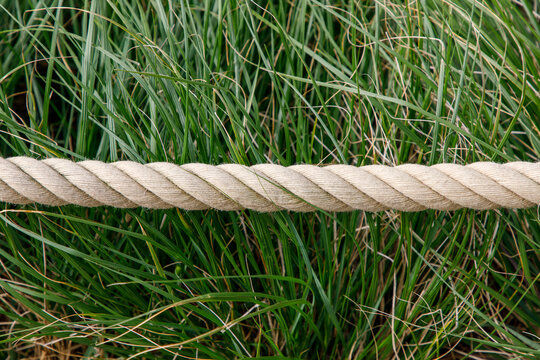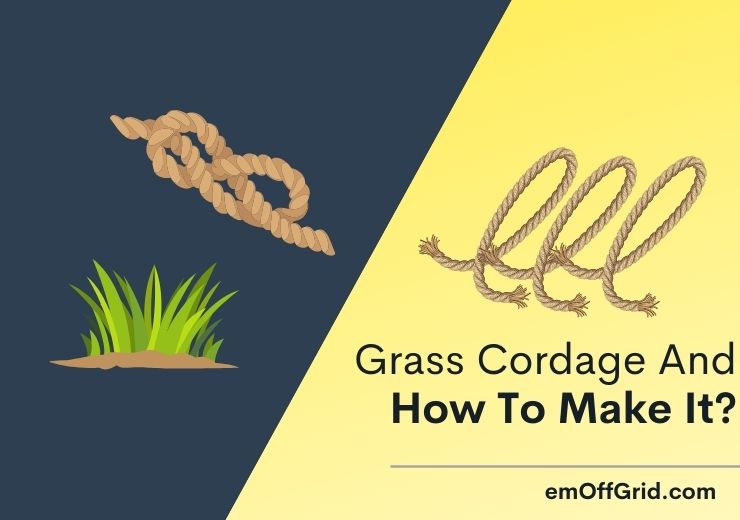Before the invention of nylon fiber, the pioneers used plant matter to make ropes or cords.
They depended on the roots, stems, and sometimes leaves but no artificial fibers. As an off-gridder, it pays to learn how to make grass cordage.
We will learn the basic steps needed to make a cord or rope from grass.
We have outlined the steps and everything you need to know about the process. Survive like a pioneer with our detailed guide.
Contents
Can You Make Cordage From Grass?

Yes. You may not think of cordage making from the grass as a DIY project. Plus, even if you do, you might not think that grass is that handy in making ropes.
Many people in the current era use sisal fibers for weaving ropes, however, grass can also be used in the same process.
The use of ropes and cords for hunting, fastening, carrying, lifting, attaching, and climbing dates back to prehistoric times.
At this time, people had no access to nylon fibers and braiding machines we have today. They could still make ropes, however, solely on grass and other plant matter.
To make ropes using grass, you have to decide on the appropriate grass variety and then harvest it. Once cut, let the grass dry before starting the weaving.
You need to let the grass dry. Otherwise, it will lose its grip and become loose, compromising the overall integrity of the rope.
You might find dry grasses from the neighborhood. However, if you cannot find such long, dry grasses, take your time to cut the green ones and let them dry.
If pioneers used natural grass for making cords without nylon fibers, you can as well.
Steps To Make Grass Cordage
Making cordage from grass is a simple, straightforward process that you can complete in three steps.
If you have all the materials with you, you can braid as long of cords as you want in one sitting. The following are the steps required to make ropes or cords from grass:
- Collect Long Grass for Cordage
- Make Grass Bundles/Strands for Twisting Cordage
- Start to Braid and Splice
The steps listed above may seem complicated, however, you will agree with us that it is far from that. Here are the detailed descriptions of each step.
Collecting Long Grass for Cordage
You can make rope from different plant materials such as grass fibers, manilla hemp, straw, flex, nettles, yucca, etc.
You can also consider linen, cotton, coir, jute, and sisal. The strength of your rope depends on the plant matter of choice.
After deciding on what you will be using to make the ropes, wear hand gloves to protect your hands.
Some grass varieties can easily slice through your skin and cause serious injuries. Also, the hidden brambles and other things in the grass can bring the whole operation to a standstill. Simply put, protect yourself.
Lastly, you need an appropriate tool for cutting the grass. Consider using a sickle grass cutter instead of a knife.
Regardless of how sharp your knife can be, it can get blunt within minutes of cutting grass. Also, do not attempt to pull off the grass with your bare hands.
To cut the grass with the sickle tool, hold a bunch of grass halfway up and sweep the base with the sickle as fast as you can.
Zenport K310 Brush Clearing Sickle
- Premium Japanese Steel Blade: The 9-inch blade is crafted from premium SK5 Japanese high-carbon steel, known for its sharpness, strength, and durability.
- Sturdy Aluminum Handle: With a 9-inch aluminum handle, the Zenport K310 sickle provides lightweight strength without compromising on power.
- Ergonomic Soft Rubber Grip: Featuring a black soft rubber grip, the handle ensures comfort during prolonged use.
Lift the grasses once sliced and put them on the ground horizontally. You need to repeat the process until you gather the quantity of grass you need.
As mentioned, you need to cure the grass to lose its water and shrink to the minimum size. You have to do it carefully, not to make it brittle but remain flexible.
Making Grass Bundles/Strands For Twisting Cordage
The second step is to make the grass bundles or strands for braiding your rope. To do that, lay the grass on the ground with their bases lined up at the same level.
Tie a knot at one end on a handful of the cured grass to make sizable bundles, depending on the overall diameter of the rope you intend to braid.
Starting To Braiding And Splicing
This is the last step you need to turn the raw material into a finished product for use. To start braiding, grab any of the prepared grass fiber bundles from the previous step and split them into two to form a V-shape at the knot.
Hold it tightly and start twisting from the knot upwards, following the same direction.
Here, it never matters if you do it clockwise or anti-clockwise. What matters is to always maintain the twisting pattern throughout.
Wrap the separated sections around one another to form a rope as you near the end of the fibers.
If you need a longer rope, grab one more section and divide it into a V-shape. Overlap the tail of the first pair with the head of the new section.
The side with the knot forms the head and the other the tail. Continue twisting until you reach near the end and continue the process.
When you have obtained the appropriate length, tie a knot near the end of the last pair of grass bundles and trim the excess grass.
Create two cords and twist them together to create one rope. That way, the final rope has more strength than the individuals.
Other Potential Materials for Cordage From Plants
Apart from the grass fibers, you can also use leaves, bark, stems, and roots to make ropes or cords.
The approach varies depending on the plant part chosen. The following are brief descriptions of using the listed sections.
Leaves

Leaves from plants such as yucca, cattail, or fern are strong enough for making cords. Yucca is very similar to sisal.
The leaves are harvested and used in weaving and rope braiding. Watch this YouTube tutorial to know how to make cords from yucca leaves.
Bark

It is not the actual bark you use for cordage. Barks of various trees have fibers on the inside. It is that which we need to extract and use.
Fortunately, most trees can produce long fibers from the back, making it easy to braid even longer ropes.
The trees whose barks you can consider for this include ash, box elder, basswood, elm, walnut, cherry, cedar, aspen, willow, cottonwood, etc. Learn how to do it from this YouTube video.
Stem

Stem or stalk fibers are also very long. By following this tutorial, you can make ropes out of the stalks of different plants.
You can consider dogbane, stinging nettle, velvetleaf, milkweed, fireweed, and evening primrose because they are known to produce long fibers for cordage.
The tutorial mentioned here focuses on making cordage from stinging nettle stalks, however, any other appropriate plant can do.
Roots
Roots harvested from spruce, Jupiter, tamarack, cedar, and pine are reliable fibers for making ropes.
You only need to cure them while maintaining their flexibility before you can braid them into cords. Follow these steps to make a strong rope from cedar roots.
JapanBargain, Saw Tooth Sickle Banana Sod Weed Grass Cutter Bush Knife
- Small Serrated Sickle allows you pull out weeds quickly. Weeding and Planting Tool for Garden and Bonsai.
- Saw Tooth Blade Garden Sickle Cuts off Even Harder Weeds, Also Great tool for Camping.
- Sickle Measures Overall 7-1/2 inches Long, 3-1/2 inches Blade Length.
Conclusion
You do not need synthetic fibers to make cords or ropes, as seen in this article.
We outlined the steps required to braid cords from natural grass and other plant parts such as barks, stalks, leaves, and roots. It is our hope that you found this information worth your time.
Kindly share it with your friends and don’t forget to check other posts at the Em Offgrid. We appreciate your time and invite you to explore the site for similar content.


